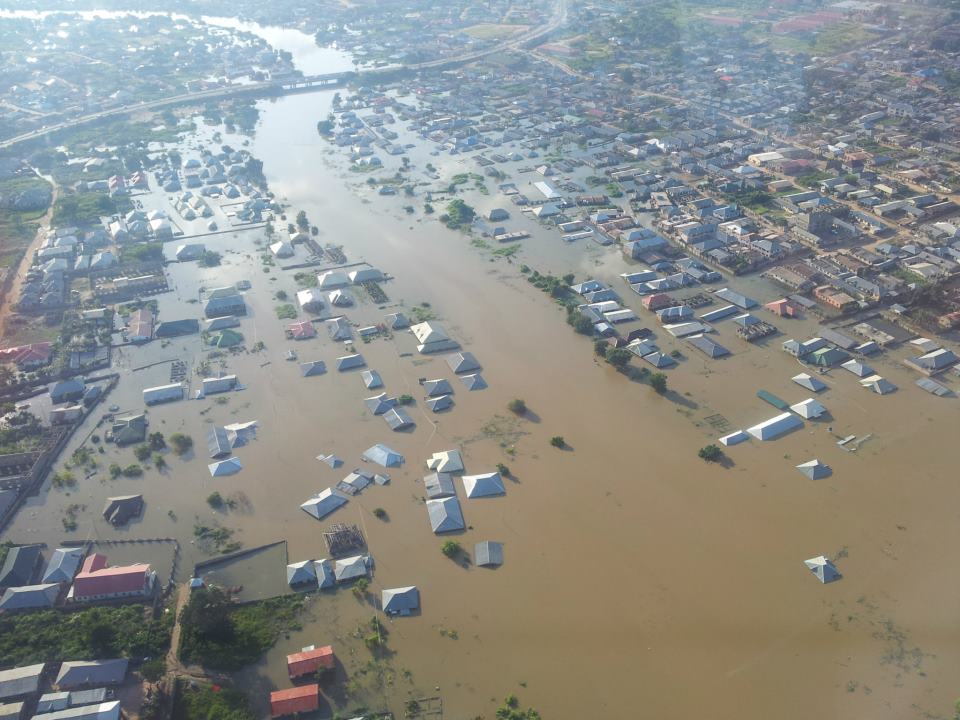Tackling Nigeria’s recurrent flood menace
A common environmental problem in Nigeria is flood and this occurs when a body of water moves over and above an area of land which is not normally submerged. It could also be seen as the inundation of an area not normally covered with water, through a temporary rise in level of stream, river, lake or […]

Arial view of flooded Lokoja, Kogi State
A common environmental problem in Nigeria is flood and this occurs when a body of water moves over and above an area of land which is not normally submerged. It could also be seen as the inundation of an area not normally covered with water, through a temporary rise in level of stream, river, lake or sea.
Flood menace in Nigeria has become a normal and re-occurring phenomenon which sometimes, has devastating impacts on human livelihoods and infrastructural development. Causes of this problem include rapid population growth, poor governance, poor drainage facilities, decaying infrastructures, lack of proper environmental planning and management strategies, among others.
- Ghana deports 16 Nigerians for engaging in cyber crimes
- National Security Council orders reopening of Dangote cement factory
This disaster often leaves in its wake, spread of diseases, loss of thousands of lives from various parts of the country and properties worth billions of naira being destroyed.
In Kogi, flooding pounded the state so hard that several houses had been submerged; belongings destroyed and lives lost. About six persons, including a toddler, were killed by the flood that sacked communities in the Ibaji Local Government Area of the state.
Over 600 hectares of rice farmland among several buildings were submerged due to the flood caused by the opening of the Lagdo dam and torrential rainfall. The woes of residents affected by the flood wrecking different parts of the state have worsened with the scarcity of potable water which the state Ministry of Water Resources said was caused by the flood.
Meanwhile, the state’s governor, Yahaya Bello, had called on the president to declare Kogi a state of national disaster, following the ravaging effect of flood in the state and environs. He added that the natural disaster had affected the nine local government areas of the state which were along River Niger and River Benue.
Also, Over 60 per cent of lands in Anambra State are currently underwater, according to the State Emergency Management Authority. The development forced the state government to order closure of schools in the areas where over 700,000 people were displaced and 300 communities sacked. Apart from submerging houses and farmlands, critical infrastructure such as schools, healthcare centres, police stations, banks, offices were also affected; a situation that made the state government to shut schools in the riverine areas.
The occurrence of flood represents a major risk to riverside populations and floodplains, in addition to causing substantial impacts on the environment, including aquatic fauna and flora. Flooding is becoming an increasingly severe and more frequent problem in Nigeria. Unfortunately, the impact is more felt by the urban poor in such a way that recovery is unlikely to be achieved without external aid. In other words, urban poor are most vulnerable to impact of flood because they set up homes in the floodplains. Flooding is one of the most devastating hazards that are likely to increase in many regions of the world partly due to global climate change and poor governance.
Floods are the most recurring, widespread, disastrous and frequent natural hazards of the world. Urban flooding has resulted in major loss of human lives; destruction of economic and social infrastructure such as water supply, electricity, roads and railway lines (means of livelihood). Flooding is an important factor responsible for the spread of diseases such as diarrhoea, typhoid, scabies, cholera and malaria.
Therefore, planning emergency measures through flood management can only reduce disastrous consequences. It should be understood that flood management is a broad spectrum of water resources activities aimed at reducing potential harmful impacts. Proper management and control of urban flood is of vital importance, and this can be feasible if there is proper and effective flood or disaster planning and management through adequate preparation and monitoring.
Furthermore, concerted efforts must be geared towards adequate city planning, policy formulation, enhanced public enlightenment programmes, integration of environmental planning and education to curriculum of schools at all levels as well as capacity building towards adaptation and mitigation of climate change.
Governments at all levels should ensure proper and effective use of ecological funds and should encourage the integration of environmental disaster insurance to take care of the fall out of flood disaster. It should be emphasized that corrupt environmental practices at all levels should be properly addressed. National disaster and emergency policies should be strengthened to facilitate effective disaster preparedness and response. This approach will not only save lives and livelihoods, but it will equally reduce vulnerability to disasters.
Finally, dangerous political interventions in land use planning and management should grossly be avoided in order to protect the occurrence of avoidable disasters and blaming of innocent professionals.
Felix Oladeji writes from Lagos
